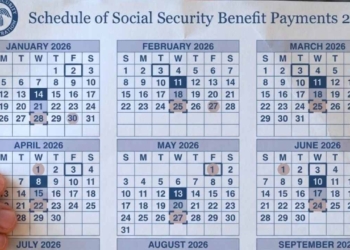Millions of Americans depend on government programs such as Supplemental Security Income (SSI), and they are all constantly aware of their schedule, which may have certain changes that could cause confusion.
This year, for the more than seven million SSI recipients in the United States—adults and children with disabilities, low-income individuals, or those age 65 and older—October 2025 is shaping up to be a month of double relief.
While the usual payment will arrive on October 1st, a second deposit will appear on the 31st of the same month. The downside? In November, there won’t be a scheduled payment on its usual date.
Why there is no SSI payment in November
This isn’t a funding cut or a change in federal policy, but rather a simple calendar mechanic that the SSA has consistently implemented for decades. Let’s unravel this step by step, calmly and clearly, so you can plan without surprises.
First, let’s review how SSI works. Unlike regular Social Security benefits, which are distributed based on a beneficiary’s birthday, SSI payments are issued uniformly: on the first day of each month. This predictability is one of the strengths of the program, designed in 1972 as a safety net for those whose work capacity is limited by age, disability, or lack of resources.
The average monthly benefit is around $650, although it varies by state and individual circumstances, and covers basic needs such as housing, food, and medical care. For many, it is the cornerstone of their economic stability. The maximum for a single recipient is $967, for a couple it goes up to $1,450, and to pay for an essential person (assistant for disabled or elderly), the top payment is $484.
Now, the key detail of 2025: November 1 falls on a Saturday.
The SSA does not process payments on weekends or federal holidays to avoid complications in the banking system and ensure the funds arrive efficiently. In these cases, the agency advances the deposit to the last business day of the previous month.
Thus, the payment for November—which would normally be the first—will be transferred on Friday, October 31st. This doesn’t mean you lose money; it simply shifts the flow. The agency will process a total of twelve payments every year, one for each regular month.
This practice isn’t new. In fact, it occurs relatively frequently, approximately once or twice a year, depending on how the weekends align with the calendar. In 2024, for example, beneficiaries received a double payment in February due to a holiday.
The 2026 COLA Is Expected to Be Delayed
The federal government initiated a shutdown on October 1, 2025, precipitating not only the suspension of non-essential operations but also a deferral of the 2026 COLA announcement for Social Security benefits. The SSA had scheduled the disclosure for October 15, predicated on the Bureau of Labor Statistics’ Consumer Price Index (CPI-W) for the third quarter.
But with everything on hold, that info is stuck in neutral until lawmakers sort out the budget mess. If you’ve been following these things like I have over the years, you know it’s more than a paperwork snag—it hits home for about 70 million folks counting on these checks, from folks winding down in small-town America to families getting SSI help in big cities.
Right now, you’re looking at sticking with the 2025 bump of 2.5%, missing out on what experts guessed might be around 2.7% next year. And get this: in a year still shaking off election vibes, with the economy growing at a steady 2.1% but debt piling up past $36 trillion, these shutdowns pop up about 15% of the time during handoff seasons. It’s a reminder that the safety net we rely on can wobble on something as shaky as a last-minute deal.







